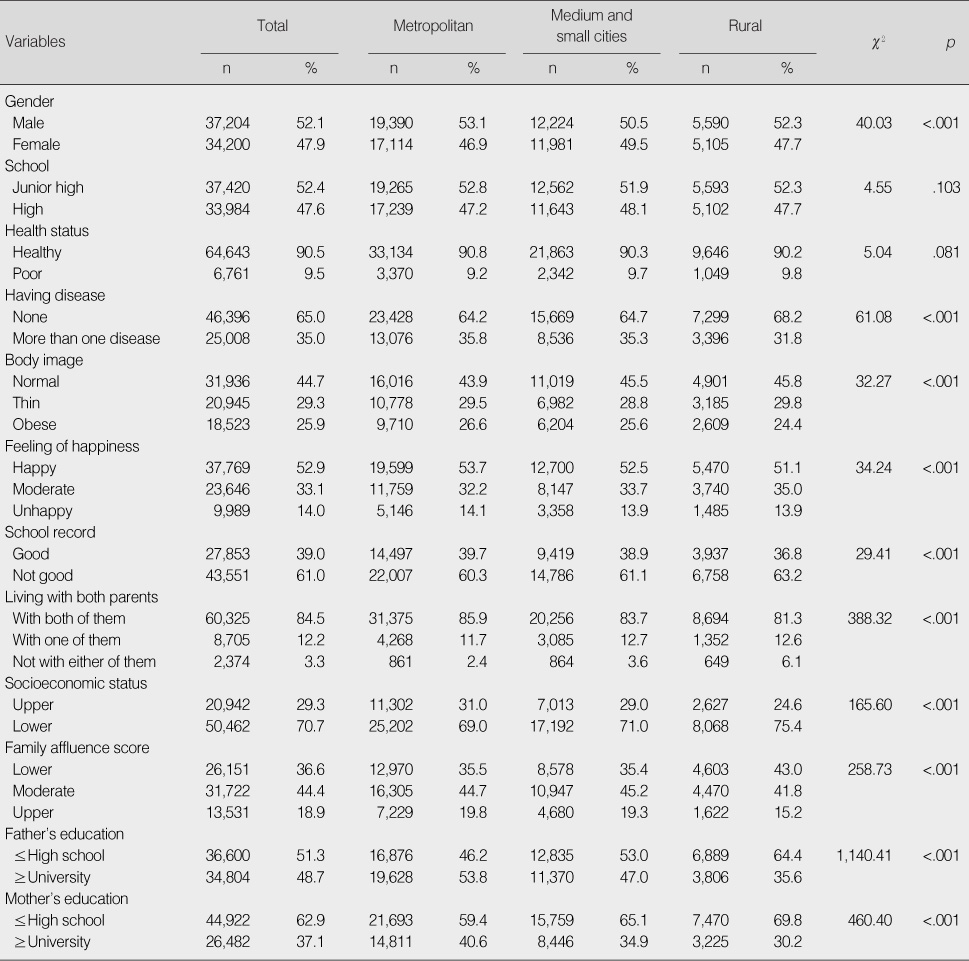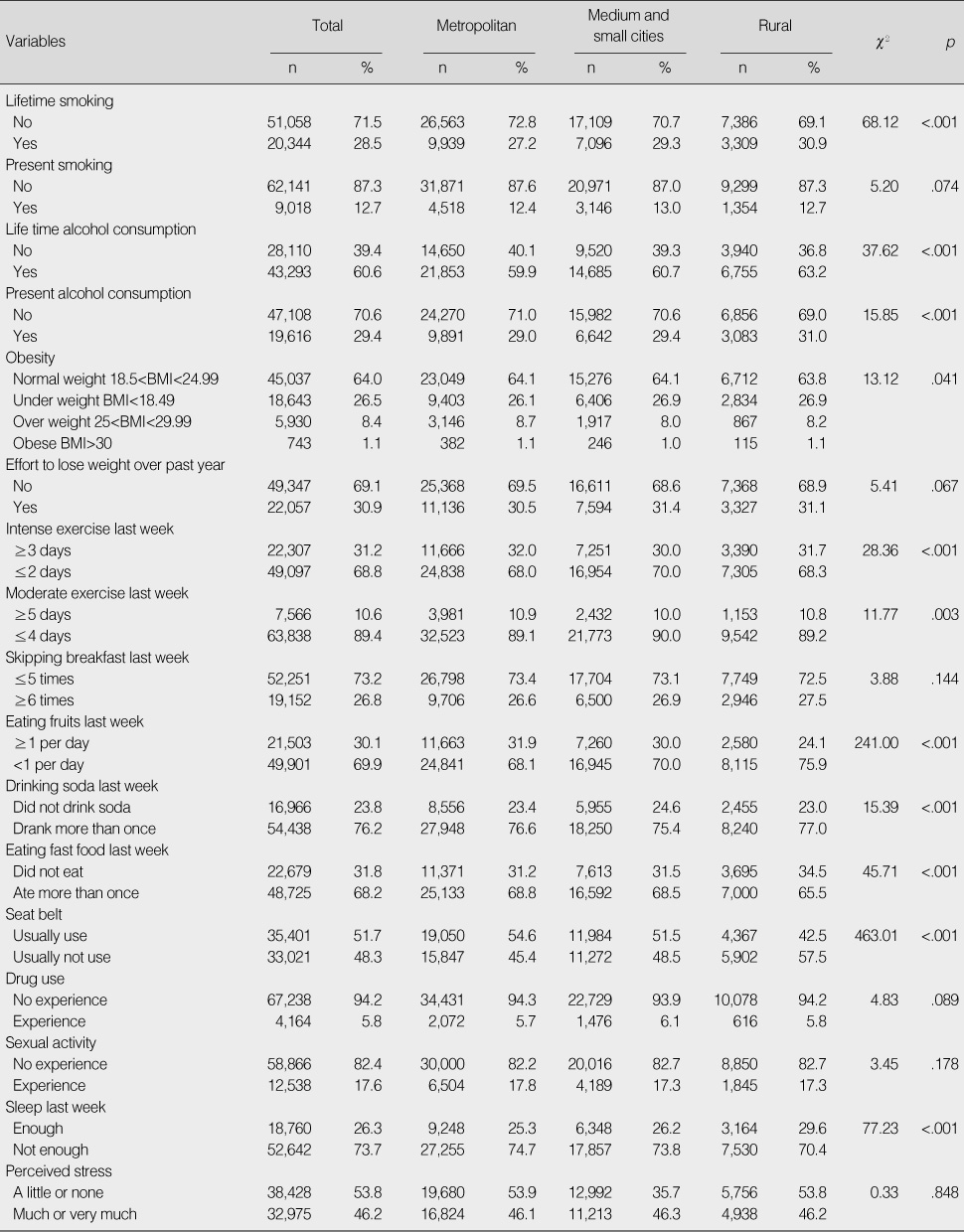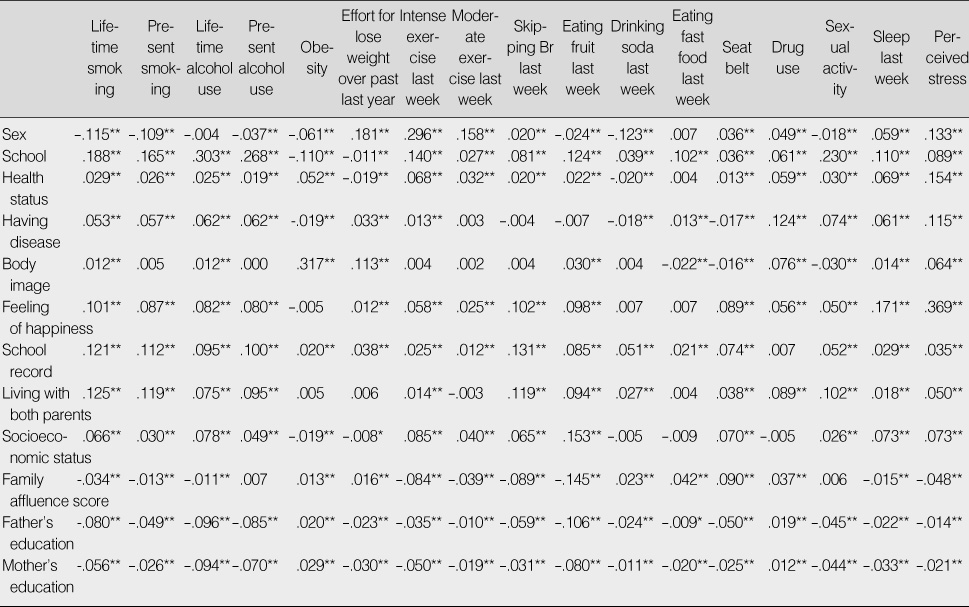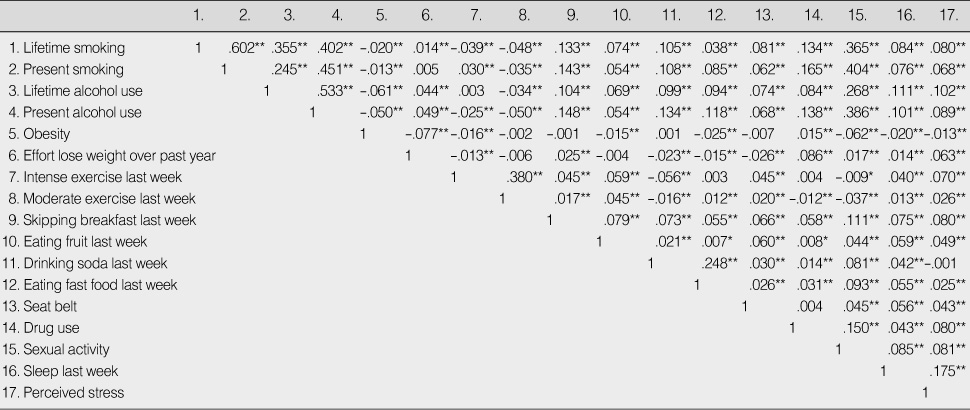Articles
- Page Path
- HOME > J Korean Acad Nurs > Volume 40(1); 2010 > Article
-
Original Article
- A Comparative Study of Youth Health Risk Behaviors by Region: Focused on Metropolitan Areas, Medium Sized and Small City Areas, and Rural Areas
- Eunok Park
-
Journal of Korean Academy of Nursing 2010;40(1):14-23.
DOI: https://doi.org/10.4040/jkan.2010.40.1.14
Published online: February 28, 2010
Associate Professor, Department of Nursing, Jeju National University, Jeju, Korea.
- Address reprint requests to: Park, Eunok. Department of Nursing, Jeju National University, 66 Ara 1-dong, Jeju 690-756, Korea. Tel: 82-64-754-3882, Fax: 82-64-702-2686, eopark@jejunu.ac.kr
• Received: March 12, 2009 • Accepted: January 13, 2010
Copyright © 2010 Korean Society of Nursing Science
Abstract
-
Purpose
- This study was done to compare health risk behavior prevalence for youth living in metropolitan, medium sized and small cities or rural area, in order to enhance understanding regional differences.
-
Methods
- For this study, data from the 2006 Youth Health Risk Behavior Online Survey collected by the Korean Center for Disease Control were analyzed using SPSS.
-
Results
- In the metropolitan areas, prevalence for disease and perceived obesity were higher than in other areas. Lack of intense or moderate physical activity, obesity, fast food intake, and insufficient sleep showed higher prevalence than in rural areas. Prevalence of lifetime smoking, lifetime alcohol consumption, present alcohol use, fruit intake less than once a day, and not wearing a seat belt were higher in rural areas than in urban areas. Gender, smoking, and alcohol use were correlated. Spearman correlation between living with parent and skipping breakfast were significant. Smoking, alcohol use, and sexual behavior were correlated.
-
Conclusion
- As significant differences in prevalence of youth health risk behaviors exist between regional areas, health education and health promotion programs considering these differences have to be developed and implemented for adolescents. Programs for prevention of smoking and alcohol use, programs for improvement of fruit intake and safety are suggested for adolescents in rural areas, whereas programs to enhance physical activity and obesity management are suggested for adolescents in metropolitan areas.
Raw data of the Second Korean Youth Health Risk Behavior On-line Survey by the Korean Center for Disease Control were used in this work.
- 1. Bae YS. The comparative study on family environment, health behaviors, health state of elementary school in urban and rural areas. 1998;Daegu, Keimyung University. Unpublished master's thesis.
- 2. Centers for Disease Control and Prevention. Youth risk behavior surveillance-United States, 2007. Morbidity and Mortality Weekly Report. 2008;57:SS-4. 1–131.PubMed
- 3. Cho NH, Lee SS, Oh YH, Moon HS, Kim SK. The recent population trend and the coping strategies. 1998;Seoul, Korea Institute for Health and Social Affairs.
- 4. Currie C, Gabhainn SN, Godeau E, Roberts C, Smith R, Currie D, et al. Inequalities in young people's health: International report from the HBSC 2005/06 survey. 2008;Copenhagen, WHO Regional Office for Europe. WHO Policy Series: Health policy for children and adolescents, No. 5.
- 5. Kang SJ. A study on health risk behavior of adolescents. 2000;Jeonju, Chonbuk National University. Unpublished master's thesis.
- 6. Kim OS. A study on Jeju high school student's health perception and health promotion behavior. 2003;Cheongju, Korea National University of Education. Unpublished master's thesis.
- 7. Kim YA. This study investigated the relationship of stress levels, social support, and health behaviors in the adolescent population. Korean Journal of Child Health Nursing. 2001;7:203–212.
- 8. Kim YT, Lee HJ, Kim YJ, Jeong SH, Choi JH, Cho HM, et al. 2007 The results of Korea youth risk behaviors. 2008;Seoul, Korea Centers for Disease Control & Prevention.
- 9. Kim YT, Lee YK, Kim YJ, Yoon PK, Park JY, Jeong SH, et al. 2006 The results of Korea youth risk behaviors. 2007;Seoul, Korea Centers for Disease Control & Prevention.
- 10. Ko YK, Yoo IY, Kang KH, Lim JY, Kim MJ, Yoo HJ. Factors related to high-risk health behavior in middle school adolescents. Journal of Korean Academy of Child Health Nursing. 2006;12:341–350.
- 11. Korean Institute for Health and Social Affairs. 1998 National health and nutrition survey. 1999;Seoul, Ministry for Health Welfare and Family Affairs.
- 12. Lee BS, Kim MY, Kim MH, Kim SY. Health belief and performance of health behaviors of some university students in Korea. Journal of Korean Academy of Nursing. 2000;30:213–224.ArticlePDF
- 13. Lee ES, Kim HY. The related factors on health risk behaviors among high school students. Journal of the Korean Society of Maternal and Child Health. 2008;12:255–265.Article
- 14. Lee JM. A comparison of the health behavior and the health condition of the elementary school pupils in the rural areas and the urban areas. 2005;Daegu, Keimyung University. Unpublished master's thesis.
- 15. Park HK. Middle school seniors in the educational districts of Gangnam showed the highest academic achievements for Korean language arts, English, & mathematics in the results of scholastic ability tests taken nationwide. The Seoul Shinmun. 2009;February 17 E4.
- 16. Park YJ, Lee SJ, Park ES, Ryu HS, Lee JW, Chang SO. A meta-analysis of explanatory variables of health promotion behavior. Journal of Korean Academy of Nursing. 2000;30:836–846.ArticlePDF
- 17. Perry CL. Creating health behavior change. how to develop community-wide programs for youth.. 1999;Thousands Oaks, CA, Sage Publicatins, Inc.
- 18. Shin DH, Kim DH, Kim DH, Kim YH, Yoon YJ, Kwon CH. The smoking rate and knowledge of smoking hazards for male high school students in urban and rural areas. Journal of the Korean Academy of Family Medicine. 1996;17:877–883.
- 19. Shin HS, Jung Y. Predicting and understanding schoolage children's health behavior. Journal of Korean Academy of Nursing. 1998;28:846–855.ArticlePDF
- 20. Son ES. The effects of high school student's health risk behaviors: Focused on some high school students in Guri city. 2004;Seoul, Ewha Womans University. Unpublished master's thesis.
- 21. Statistics Korea. 2007 Annual report on the cause of death statistics. 2008;Daejeon, Author.
- 22. Statistics Korea. 2007 Social indicators in Korea. 2008;Daejeon, Author.
- 23. Tak YR, Yun EH. Youth health risk behavior survey on adolescents in urban setting. Journal of the Korean Society of School Health. 2007;20:11–24.
REFERENCES
Figure & Data
REFERENCES
Citations
Citations to this article as recorded by 

- Epidemiological trends in diabetic renal complications in United States adults: A center for disease control and prevention wide-ranging online data for epidemiologic research analysis (1999-2020)
Abdullah Naveed Muhammad, Faizan Ahmed, Sherif Eltawansy, Ahila Ali, Bazil Azeem, Muhammad Kashan, Zaima Afzaal, Mushood Ahmed, Kainat Aman, Aman Amanullah, Muhammad Naveed Uz Zafar, Pawel Lajczak, Ogechukwu Obi
World Journal of Nephrology.2025;[Epub] CrossRef - A comparative study on eating habits and mental health of Korean middle school students according to their bedtime across regions: using data from the 2020–2022 Korea Youth Risk Behavior Survey
Sarim Kim, Jiyoung Jeong, Juyeon Kang, Jihye Kim, Yoon Jung Yang
Nutrition Research and Practice.2024; 18(2): 269. CrossRef - Latent Class Analysis of Obesogenic Behaviors among Korean Adolescents: Associations with Weight-Related Outcomes
Haein Lee, In-Seo La
International Journal of Environmental Research and Public Health.2021; 18(21): 11059. CrossRef - Differences in Health Behavior Profiles of Adolescents in Urban and Rural Areas in a Korean City
Myungah Chae, Kihye Han
Healthcare.2021; 9(3): 282. CrossRef - Association Between Socioeconomic Status and Early Initiation of Smoking, Alcohol Drinking, and Sexual Behavior Among Korean Adolescents
Mei Lin C. Valencia, Binh Thang Tran, Min Kyung Lim, Kui Son Choi, Jin-Kyoung Oh
Asia Pacific Journal of Public Health.2019; 31(5): 443. CrossRef - Relationship between health risk behaviors, oral health-related behaviors, and experiences of oral symptoms in Korean adolescents: based on 2018 Korea Youth Risk Behavior Web-based Survey
Sun Rak Jeong, Ji Eon Jang
Journal of Korean Academy of Oral Health.2019; 43(3): 149. CrossRef - Associations of Community Water Fluoridation with Caries Prevalence and Oral Health Inequality in Children
Han-Na Kim, Jeong-Hee Kim, Se-Yeon Kim, Jin-Bom Kim
International Journal of Environmental Research and Public Health.2017; 14(6): 631. CrossRef - Health Behaviors and Academic Performance Among Korean Adolescents
Eun Sun So, Byoung Mo Park
Asian Nursing Research.2016; 10(2): 123. CrossRef - Impact of Health Risk Factors on the Oral Health of Korean Adolescents: Korea Youth Risk Behavior Web-Based Survey, 2013
Kyung-Yi Do
Journal of dental hygiene science.2016; 16(3): 193. CrossRef - Associations between Weight Control Behavior and Health Behaviors in Korean Young Women: 2013 Community Health Survey
Jae-Hee Kim
Journal of the Korea Academia-Industrial cooperation Society.2015; 16(7): 4734. CrossRef - The Relationship between Internet Use and Health Behaviors among Adolescents
Eun Gyeong Kim
Journal of Korean Academy of Community Health Nursing.2015; 26(1): 52. CrossRef - The Prevalence and the Related Factors of Metabolic Syndrome in Urban and Rural Community
Moon Jeong Kim, Eunok Park
Korean Journal of Adult Nursing.2014; 26(1): 67. CrossRef - Health Behaviors and Related Demographic Factors among Korean Adolescents
YunHee Shin, Sook Jung Kang
Asian Nursing Research.2014; 8(2): 150. CrossRef - Associations of Eating Habits with Obesity and Nutrition Knowledge for Middle and High School Adolescents in Shanghai and Heze China
Yang Song, Hyo-Jin Ahn, Ji-Hye Choi, Se-Young Oh
Journal of The Korean Society of Food Culture.2014; 29(6): 648. CrossRef - Socioeconomic and geographic inequalities in adolescent smoking: A multilevel cross-sectional study of 15 year olds in Scotland
K.A. Levin, R. Dundas, M. Miller, G. McCartney
Social Science & Medicine.2014; 107: 162. CrossRef - Influence of Ego-resilience and Stress Coping Styles on College Adaptation in Nursing Students
Jin Ah Park, Eun Kyung Lee
Journal of Korean Academy of Nursing Administration.2011; 17(3): 267. CrossRef - Trends in Cigarette Use Behaviors Among Adolescents by Region in Korea
Nam Soo Hong, Keon Yeop Kim, Soon-Woo Park, Jong-Yeon Kim, Jisuk Bae, Won Kee Lee, Ki Su Kim
Journal of Preventive Medicine and Public Health.2011; 44(4): 176. CrossRef
A Comparative Study of Youth Health Risk Behaviors by Region: Focused on Metropolitan Areas, Medium Sized and Small City Areas, and Rural Areas
A Comparative Study of Youth Health Risk Behaviors by Region: Focused on Metropolitan Areas, Medium Sized and Small City Areas, and Rural Areas
Sociodemographic Characteristics of Study Participants by Regions (N=71,404)
Youth Health Risk Behaviors by Regions (N=71,404)
BMI=body mass index.
Spearman Correlation between Subjects' Characteristics and Health Risk Behaviors
**p<.01.
Spearman Correlation Coefficients between Health Risk Behaviors
*p<.05; **p<.01.
Table 1
Sociodemographic Characteristics of Study Participants by Regions (N=71,404)
Table 2
Youth Health Risk Behaviors by Regions (N=71,404)
BMI=body mass index.
Table 3
Spearman Correlation between Subjects' Characteristics and Health Risk Behaviors
**p<.01.
Table 4
Spearman Correlation Coefficients between Health Risk Behaviors
*p<.05; **p<.01.
 KSNS
KSNS
 E-SUBMISSION
E-SUBMISSION




 Cite
Cite

